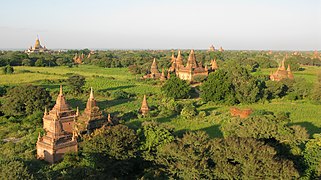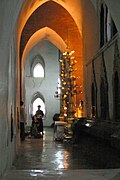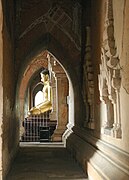Bagan
Bagan
ပုဂံ Pagan | |
|---|---|
MST ) | |
| Website | |
| Official name | Bagan |
| Location | Mandalay Region, Myanmar |
| Criteria | Cultural: iii, iv, vi |
| Reference | 1588 |
| Inscription | 2019 (43rd Session) |
| Area | 5,005.49 ha (12,368.8 acres) |
| Buffer zone | 18,146.83 ha (44,841.8 acres) |
Bagan (
of which the remains of over 2200 temples and pagodas survive.The Bagan Archaeological Zone is a main attraction for the country's nascent tourism industry.[3]
Etymology
Bagan is the present-day
History
9th to 13th centuries


According to the
From 1044 to 1287, Bagan was the capital as well as the political, economic and cultural nerve center of the
The culture of Bagan was dominated by religion. The religion of Bagan was fluid, syncretic and by later standards, unorthodox. It was largely a continuation of religious trends in the
Bagan's basic physical layout had already taken shape by the late 11th century, which was the first major period of monument building. A main strip extending for about 9 km along the east bank of the Irrawaddy emerged during this period, with the walled core (known as "Old Bagan") in the middle. 11th-century construction took place throughout this whole area and appears to have been relatively decentralized. The spread of monuments north and south of Old Bagan, according to Hudson, Nyein Lwin, and Win Maung, may reflect construction at the village level, which may have been encouraged by the main elite at Old Bagan.[9]: 51
The peak of monument building took place between about 1150 and 1200. Most of Bagan's largest buildings were built during this period. The overall amount of building material used also peaked during this phase. Construction clustered around Old Bagan, but also took place up and down the main strip, and there was also some expansion to the east, away from the Irrawaddy.[9]: 50–1
By the 13th century, the area around Old Bagan was already densely packed with monuments, and new major clusters began to emerge to the east. These new clusters, like the monastic area of Minnanthu, were roughly equally distant – and equally accessible – from any part of the original strip that had been defined in the 11th century. Construction during the 13th century featured a significant increase in the building of monasteries and associated smaller monuments. Michael Aung-Thwin has suggested that the smaller sizes may indicate "dwindling economic resources" and that the clustering around monasteries may reflect growing monastic influence. Bob Hudson, Nyein Lwin, and Win Maung also suggest that there was a broadening of donor activity during this period: "the religious merit that accrued from endowing an individual merit was more widely accessible", and more private individuals were endowing small monuments. As with before, this may have taken place at the village level.[9]: 51–2, 61
Both Bagan itself and the surrounding countryside offered plenty of opportunities for employment in various sectors. The prolific temple building alone would have been a huge stimulus for professions involved in their construction, such as brickmaking and masonry; gold, silver, and bronze working; carpentry and woodcarving; and ceramics. Finished temples would still need maintenance work done, so they continued to boost demand for both artisans' services and unskilled labor well after their construction. Accountants, bankers, and scribes were also necessary to manage the temple properties. These workers, especially the artisans, were paid well, which attracted many people to move to Bagan. Contemporary inscriptions indicate that "people of many linguistic and cultural backgrounds lived and worked" in Bagan during this time period. [10]: 305–7
Bagan's ascendancy also coincided with a period of political and economic decline in several other nearby regions, like Dvaravati, Srivijaya, and the Chola Empire. As a result, immigrants from those places likely also ended up moving to Bagan, in addition to people moving there from within Myanmar.[10]: 306
The Pagan Empire collapsed in 1287 due to repeated Mongol invasions (1277–1301). Recent research shows that Mongol armies may not have reached Bagan itself, and that even if they did, the damage they inflicted was probably minimal.[11] According to Michael Aung-Thwin, a more likely explanation is that the provincial governors tasked with defending against Mongol incursions were so successful that they became "the new power elite", and their capitals became the new political centers while Bagan itself became a backwater.[9]: 53 In any case, something during this period caused Bagan to decline. The city, once home to some 50,000 to 200,000 people, had been reduced to a small town, never to regain its preeminence. The city formally ceased to be the capital of Burma in December 1297 when the Myinsaing Kingdom became the new power in Upper Burma.[12][13]
14th to 19th centuries

Bagan survived into the 15th century as a human settlement,[14] and as a pilgrimage destination throughout the imperial period. A smaller number of "new and impressive" religious monuments still went up to the mid-15th century but afterward, new temple constructions slowed to a trickle with fewer than 200 temples built between the 15th and 20th centuries.[2] The old capital remained a pilgrimage destination but pilgrimage was focused only on "a score or so" most prominent temples out of the thousands such as the Ananda, the Shwezigon, the Sulamani, the Htilominlo, the Dhammayazika, and a few other temples along an ancient road. The rest—thousands of less famous, out-of-the-way temples—fell into disrepair, and most did not survive the test of time.[2]
For the few dozen temples that were regularly patronized, the continued patronage meant regular upkeep as well as architectural additions donated by the devotees. Many temples were repainted with new frescoes on top of their original Pagan era ones, or fitted with new Buddha statutes. Then came a series of state-sponsored "systematic" renovations in the Konbaung period (1752–1885), which by and large were not true to the original designs—some finished with "a rude plastered surface, scratched without taste, art or result". The interiors of some temples were also whitewashed, such as the Thatbyinnyu and the Ananda. Many painted inscriptions and even murals were added in this period.[15]
20th century to present
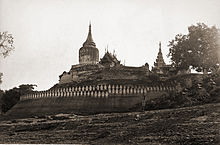
Bagan, located in an active earthquake zone, had suffered from many earthquakes over the ages, with over 400 recorded earthquakes between 1904 and 1975.
Many of these damaged pagodas underwent restorations in the 1990s by the military government, which sought to make Bagan an international tourist destination. However, the restoration efforts instead drew widespread condemnation from art historians and preservationists worldwide. Critics are aghast that the restorations paid little attention to original architectural styles, and used modern materials, and that the government has also established a golf course, a paved highway, and built a 61 m (200 ft) watchtower. Although the government believed that the ancient capital's hundreds of (unrestored) temples and large corpus of stone inscriptions were more than sufficient to win the designation of UNESCO World Heritage Site,[19] the city was not so designated until 2019, allegedly mainly on account of the restorations.[20]
Bagan today is a main tourist destination in the country's nascent tourism industry, which has long been the target of various boycott campaigns. Several Burmese publications note that the city's small tourism infrastructure will have to expand rapidly even to meet a modest pickup in tourism in the following years.
On 24 August 2016, a
On 6 July 2019, Bagan was officially inscribed as a World Heritage Site by UNESCO, after 24 years since the military government first nominated the city in 1995, during the 43rd session of the World Heritage Committee.[21] This makes Bagan the second World Heritage Site in Myanmar, after the Ancient Cities of Pyu. As part of the criteria for the inscription of Bagan, the government of Myanmar has pledged to relocate existing hotels in the archaeological zone to a dedicated hotel zone by 2020.[22]
Geography
The Bagan Archaeological Zone, defined as the 13 km × 8 km (8.1 mi × 5.0 mi) area centred around Old Bagan, consisting of
Climate
Bagan lies in the middle of the
Available online climate sources report Bagan climate quite differently.
| Climate data for Bagan | |||||||||||||
|---|---|---|---|---|---|---|---|---|---|---|---|---|---|
| Month | Jan | Feb | Mar | Apr | May | Jun | Jul | Aug | Sep | Oct | Nov | Dec | Year |
| Mean daily maximum °C (°F) | 32 (90) |
35 (95) |
36 (97) |
37 (99) |
33 (91) |
30 (86) |
30 (86) |
30 (86) |
30 (86) |
32 (90) |
32 (90) |
32 (90) |
32 (91) |
| Mean daily minimum °C (°F) | 18 (64) |
19 (66) |
22 (72) |
24 (75) |
25 (77) |
25 (77) |
24 (75) |
24 (75) |
24 (75) |
24 (75) |
22 (72) |
19 (66) |
23 (72) |
| Source: www.holidaycheck.com[23] | |||||||||||||
| Climate data for Bagan | |||||||||||||
|---|---|---|---|---|---|---|---|---|---|---|---|---|---|
| Month | Jan | Feb | Mar | Apr | May | Jun | Jul | Aug | Sep | Oct | Nov | Dec | Year |
| Mean daily maximum °C (°F) | 28 (82) |
32 (90) |
36 (97) |
39 (102) |
38 (100) |
35 (95) |
33 (91) |
32 (90) |
32 (90) |
31 (88) |
29 (84) |
27 (81) |
33 (91) |
| Mean daily minimum °C (°F) | 16 (61) |
19 (66) |
24 (75) |
28 (82) |
29 (84) |
27 (81) |
26 (79) |
25 (77) |
25 (77) |
24 (75) |
20 (68) |
17 (63) |
23 (74) |
| Average rainfall mm (inches) | 5 (0.2) |
0.6 (0.02) |
2.6 (0.10) |
16.4 (0.65) |
49.6 (1.95) |
69.8 (2.75) |
126.7 (4.99) |
182 (7.2) |
152.4 (6.00) |
103.6 (4.08) |
25.5 (1.00) |
5.7 (0.22) |
739.9 (29.16) |
| Average rainy days | 2 | 1 | 2 | 9 | 14 | 21 | 26 | 28 | 24 | 20 | 6 | 2 | 155 |
| Source: www.weatheronline.com[24] | |||||||||||||
Cityscape
Architecture
Bagan stands out for not only the sheer number of religious edifices of Myanmar but also the magnificent architecture of the buildings, and their contribution to Burmese temple design. The artistry of the architecture of pagodas in Bagan proves the achievement of Myanmar craftsmen in handicrafts. The Bagan temple falls into one of two broad categories: the stupa-style solid temple and the gu-style (ဂူ) hollow temple.
Stupas
A stupa, also called a pagoda or chedi, is a massive structure, typically with a relic chamber inside. The Bagan stupas or pagodas evolved from earlier Pyu designs, which in turn were based on the stupa designs of the
Originally, a Ceylonese stupa had a hemispheric body (
The original Indic design was gradually modified first by the
Hollow temples
In contrast to the stupas, the hollow gu-style temple is a structure used for meditation, devotional worship of the Buddha and other Buddhist rituals. The gu temples come in two basic styles: "one-face" design and "four-face" design—essentially one main entrance and four main entrances. Other styles such as five-face and hybrids also exist. The one-face style grew out of 2nd century Beikthano, and the four-face out of 7th century Sri Ksetra. The temples, whose main features were the pointed arches and the vaulted chamber, became larger and grander in the Bagan period.[30]
Innovations
Although the Burmese temple designs evolved from Indic, Pyu (and possibly Mon) styles, the techniques of vaulting seem to have developed in Bagan itself. The earliest vaulted temples in Bagan date to the 11th century, while the vaulting did not become widespread in India until the late 12th century. The masonry of the buildings shows "an astonishing degree of perfection", where many of the immense structures survived the 1975 earthquake more or less intact.
Another architectural innovation originated in Bagan is the Buddhist temple with a pentagonal floor plan. This design grew out of hybrid (between one-face and four-face designs) designs. The idea was to include the veneration of the
Notable cultural sites


| Name | Picture | Built | Sponsor(s) | Notes |
|---|---|---|---|---|
| Ananda Temple | 
|
1105 | King Kyansittha | One of the most famous temples in Bagan; 51 m (167 ft) tall |
| Bupaya Pagoda | 
|
c. 850 | King Pyu Saw Hti | In Pyu style; original 9th century pagoda destroyed by the 1975 earthquake; completely rebuilt, now gilded
|
| Dhammayangyi Temple | 
|
1167–1170 | King Narathu | Largest of all temples in Bagan |
| Dhammayazika Pagoda | 
|
1196–1198 | King Sithu II | |
| Gawdawpalin Temple | 
|
c. 1211–1235 | King Sithu II and King Htilominlo | |
| Gubyaukgyi Temple (Wetkyi-in) | Early 13th Century | King Kyansittha | ||
| Gubyaukgyi Temple (Myinkaba) | 
|
1113 | Prince Yazakumar | |
| Htilominlo Temple | 
|
1218 | King Htilominlo | 46 m (151 ft), 3-story temple |
| Lawkananda Pagoda | 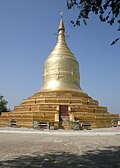
|
c. 1044–1077 | King Anawrahta | |
| Mahabodhi Temple | 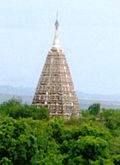
|
c. 1218 | King Htilominlo | Smaller replica of the Mahabodhi Temple in Bodh Gaya |
| Manuha Temple | 
|
1067 | King Manuha | |
| Mingalazedi Pagoda | 
|
1268–1274 | King Narathihapate | |
| Minyeingon Temple | 
|
|||
| Myazedi inscription | 
|
1112 | Prince Yazakumar | "Rosetta Stone of Burma" with inscriptions in four languages: Pyu, Old Mon, Old Burmese and Pali |
| Nanpaya Temple | 
|
c. 1160–1170 | Hindu temple in Mon style; believed to be either Manuha's old residence or built on the site | |
| Nathlaung Kyaung Temple | 
|
c. 1044–1077 | Hindu temple | |
| Payathonzu Temple | 
|
c. 1200 | in Tantric -styles
| |
| Seinnyet Nyima Pagoda and Seinnyet Ama Pagoda | 
|
11th century | ||
| Shwegugyi Temple | 
|
1131 | King Sithu I | Sithu I was assassinated here; known for its arched windows |
| Shwesandaw Pagoda | 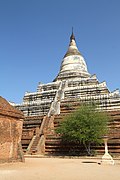
|
c. 1057 | King Anawrahta | 100 m (328 ft) tall without counting the hti spire; Tallest Pagoda in Bagan |
| Shwezigon Pagoda | 
|
1102 | King Anawrahta and King Kyansittha | |
| Sulamani Temple | 
|
1183 | King Sithu II | |
| Tharabha Gate | 
|
c. 1020 | King Kunhsaw Kyaunghpyu and King Kyiso | The only remaining part of the old walls; radiocarbon dated to c. 1020[31] |
| Thatbyinnyu Temple | 
|
1150/51 | Sithu I | 66 m (217 ft); Tallest temple in Bagan |
| Tuywindaung Pagoda | 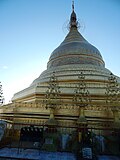
|
Anawrahta |
The walled core of "Old Bagan"
The 140-hectare core on the riverbank is surrounded by three walls. A fourth wall, on the western side, may have once existed before being washed away by the river at some point. The Irrawaddy has certainly eroded at least some parts of the city, since there are "buildings collapsing into the river both upstream and downstream from the walled core".[9]: 66
The walled core called "Old Bagan" takes up only a tiny fraction of the 8,000-hectare area where monuments are found. It is also much smaller than the walled areas of major Pyu cities (the largest, Śrī Kṣetra or Thayekittaya, has a walled area of 1,400 hectares). Altogether, this suggests that "'Old Bagan' represents an elite core, not an urban boundary".[9]: 66
Outlying sites
Otein Taung
An important outlying site is at Otein Taung, 2 km south of the Ananda temple in the walled city of Old Bagan. The name "Otein Taung" is a descriptive name meaning "pottery hill"; there is another Otein Taung on the north side of Beikthano. The site of Otein Taung at Bagan actually consists of two different mounds separated by 500 meters. Both are "covered with dense layers of fragmented pottery, and with scatters of potsherds visible around and between them". Local farm fields for crops like maize come right up to the edges of the mounds, and goats and cattle commonly graze on them.[9]: 53
Besides the mounds, there are also about 40 small monuments at Otein Taung, mostly dated to the 13th century. Several of these are clustered around a monastery on the south side of the western mound. There is also a group of monuments arranged in a straight line, which may represent a property boundary or road. Another cluster exists south of the eastern mound, and then there are also randomly scattered monuments in the area between the mounds. Finally, there is a large temple between the two mounds, which was probably built in the 12th century. This temple was restored in 1999.[9]: 53, 61
Otein Taung was excavated by a team led by Bob Hudson and Nyein Lwin in 1999 and 2000. Excavation revealed layers of potash with a fine texture, suggesting that most of the fuel was provided by bamboo and other grasses. Also found were small charcoal fragments, preserved burnt bamboo filaments, and some animal bones and pigs' teeth. Based on radiocarbon dating, Otein Taung dates from at least the 9th century, which is well before recorded history at Bagan.[9]: 53–4, 61, 70
The sprinkler pot, or kendi, is a very characteristic type of pottery from medieval Myanmar, and over 50 spouts and necks belonging to them were found by archaeologists at Otein Taung. These were all straight, in contrast to the bent spouts found at Beikthano. Also found at Otein Taung are earthenware tubes, about 60 cm long and 40 cm in diameter. Similar pipes have been found at Old Bagan, and they are thought to have been part of toilets.[9]: 58–9
It is not clear whether Otein Taung represents a large-scale pottery production site or "a huge, and for Bagan unique, residential midden". Archaeologists did not find any "slumps characteristic of overfiring in a stoneware kiln, [or] any large brick or earth structures suggesting a pottery kiln", but several "earthenware anvils" were found at the site, as well as a 10-cm-long clay tube that may have been used as a stamp for decorating pots. The anvils are common potters' tools in South and Southeast Asia: they are held inside a pot while the outside is beaten with a paddle.[9]: 55–6
If Otein Taung was used as a pottery production site, then it would have had good access to natural clay resources: the Bagan area has clayey subsoil that is "still mined today for brickmaking". There are four tanks within 500 m of Otein Taung that may have originated as clay pits.[9]: 55–6
Museums

- The Bagan Archaeological Museum: The only museum in the Bagan Archaeological Zone. The three-story museum houses a number of rare Bagan period objects including the original Rosetta stoneof Burma.
- Anawrahta's Palace: It was rebuilt in 2003 based on the extant foundations at the old palace site.[32] But the palace above the foundation is completely conjectural.
3D Documentation with LiDAR
The
Transport
Bagan is accessible by air, rail, bus, car and river boat.
Air
Most international tourists fly to the city. The
Rail
The city is on a spur from the
Buses and cars
Overnight buses and cars also operate to and from Yangon and Mandalay taking approximately 9 and 6 hours respectively.[35]
Boat
An 'express' ferry service runs between Bagan and Mandalay. Following the Irrawaddy river the fastest ferry takes around 9 hours to travel the 170 kilometres. The service runs daily during peak periods and slower sailings with overnight stops are also available.
Economy

Bagan's economy is based mainly on tourism. Because of boycotts against the previous military government, the Bagan region's tourism infrastructure is still quite modest by international standards. The city has a few international standard hotels and many family-run guesthouses. Bagan is also the center of Burmese lacquerware industry, which to a large degree depends on tourist demand. Much of the lacquerware is destined for souvenir shops in Yangon, and to the world markets. Moreover, the lacquerware-making process itself has become a tourist draw.
Demographics
The population of Bagan in its heyday is estimated to be anywhere between 50,000[37] and 200,000 people.[38] Until the advent of tourism industry in the 1990s, only a few villagers lived in Old Bagan. The rise of tourism has attracted a sizable population to the area. Because Old Bagan is now off limits to permanent dwellings, much of the population reside in either New Bagan, south of Old Bagan, or Nyaung-U, north of Old Bagan. The majority of native residents are Bamar.
Administration
The Bagan archaeological zone is part of Nyaung-U District, Mandalay Region.
Sister cities
Gallery
-
Bagan Plains
-
Bagan Plains
-
As seen from the Nanmyint Viewing Tower
-
Aerial views from a hot air balloon
-
Bagan temples at sunset
-
Bagan Plains at sunset
-
Htilominlo Temple and other temples
-
The Gawdawpalin
-
The Dhammayangyi
-
The Shwezigon
-
Doorway to a temple
-
One of the main four Buddha statutes inside the Ananda
-
A hallway inside the Ananda
-
Inside the Htilominlo
-
Frescoes inside a temple
-
Buddha statutes inside the Dhammayangyi
-
Inside the Manuha Temple
See also
- Buddhism in Myanmar
- Burmese pagoda
- Pagoda festival
- Index of Buddhism-related articles
- List of Pagodas in Bagan
Notes
- ^ "Seven more cultural sites added to UNESCO's World Heritage List". UNESCO. 6 July 2019. Archived from the original on 14 July 2019. Retrieved 6 July 2019.
- ^ a b c d Stadtner 2011: 216
- ^ "Business: The promise—and the pitfalls". The Economist. 25 May 2013. Archived from the original on 2017-11-07. Retrieved 2018-11-26.
- ^ Than Tun 1964: 117–118
- ^ Maha Yazawin Vol. 1 2006: 139–141
- ^ Harvey 1925: 18
- ^ Lieberman 2003: 90–91
- ^ a b Lieberman 2003: 115–116
- ^ a b c d e f g h i j k l Hudson, Bob; Nyein Lwin; Win Maung (2001). "The Origins of Bagan: New Dates and Old Inhabitants". Asian Perspectives. 40 (1): 48–74. Retrieved 2 January 2024.
- ^ ISBN 0-8248-2886-0. Retrieved 14 January 2024.
- ^ Lieberman 2003: 119–120
- ^ Htin Aung 1967: 74
- ^ Than Tun 1959: 119–120
- ^ Aung-Thwin 1985: 196–197
- ^ Stadtner 2011: 217
- ^ Unesco 1976: ix
- ^ Ishizawa and Kono 1989: 114
- ^ Köllner, Bruns 1998: 117
- ^ a b Unesco 1996
- ^ Tourtellot 2004
- ^ "Myanmar's temple city Bagan awarded UNESCO World Heritage status". CNA. Archived from the original on 2019-07-07. Retrieved 2019-07-07.
- ^ "Bagan named UNESCO World Heritage Site". The Myanmar Times. 7 July 2019. Archived from the original on 2021-07-29. Retrieved 2019-07-07.
- ^ "Weather for Bagan". www.holidaycheck.com. Archived from the original on 2013-01-25. Retrieved 2012-02-19.
- ^ "Weather for Bagan". www.worldweatheronline.com. Archived from the original on 2021-07-29. Retrieved 2021-03-03.
- ^ Aung-Thwin 2005: 26–31
- ^ a b Aung-Thwin 2005: 233–235
- ^ a b c d Köllner, Bruns 1998: 118–120
- ISBN 9625938826.
- ^ Aung-Thwin 2005: 210–213
- ^ Aung-Thwin 2005: 224–225
- ^ Aung-Thwin 2005: 38
- ^ Ministry of Culture
- ^ "Site - Bagan". zamaniproject.org. Archived from the original on 2019-09-25. Retrieved 2019-09-27.
- ^ "Laser Scanning for Heritage Conservation - Bagan, Myanmar -". lidarnews.com. 2017-07-01. Archived from the original on 2019-09-26. Retrieved 2019-09-26.
- ^ a b "Getting to Bagan Myanmar". Visit Bagan. 16 March 2019. Archived from the original on 10 November 2017. Retrieved 31 March 2015.
- ^ a b "Train Travel in Myanmar". The man in seat 61... Archived from the original on 2009-01-30. Retrieved 2015-03-31.
- ^ Harvey 1925: 78
- ^ Köllner, Bruns 1998: 115
- ^ a b Pan Eiswe Star and Soe Than Linn 2010
References
- Aung-Thwin, Michael (1985). Pagan: The Origins of Modern Burma. Honolulu: University of Hawai'i Press. ISBN 0-8248-0960-2.
- Aung-Thwin, Michael (2005). The mists of Rāmañña: The Legend that was Lower Burma (illustrated ed.). Honolulu: University of Hawai'i Press. ISBN 978-0-8248-2886-8.
- Ministry of Culture, Union of Myanmar (2009). "Royal Palaces in Myanmar". Ministry of Culture. Archived from the original on 2012-08-03. Retrieved 2012-02-19.
- Harvey, G. E. (1925). History of Burma: From the Earliest Times to 10 March 1824. London: Frank Cass & Co. Ltd.
- Htin Aung, Maung (1967). A History of Burma. New York and London: Cambridge University Press.
- Ishizawa, Yoshiaki; Yasushi Kono (1989). Study on Pagan: research report. Institute of Asian Cultures, Sophia University. p. 239.
- Kala, U (1724). Maha Yazawin (in Burmese). Vol. 1–3 (2006, 4th printing ed.). Yangon: Ya-Pyei Publishing.
- Köllner, Helmut; Axel Bruns (1998). Myanmar (Burma) (illustrated ed.). Hunter Publishing. p. 255. ISBN 978-3-88618-415-6.
- ISBN 978-0-521-80496-7.
- Pan Eiswe Star; Soe Than Linn (2010-02-10). "Archaeologists to assist with Cambodia excavations". The Myanmar Times. 26 (509).
- Ministry of Information, Myanmar.
- Rao, V.K. (2013). "The Terracotta Plaques of Pagan: Indian Influence and Burmese Innovations". Ancient Asia. 4: 7. doi:10.5334/aa.12310.
- Rao, Vinay Kumar. "Buddhist Art of Pagan, 2 Vols". Published by Agam Kala Publications, New Delhi, 2011. ISBN 978-81-7320-116-5.
- Rao, Vinay Kumar (2013). "The Terracotta Plaques of Pagan: Indian Influence and Burmese Innovations". Ancient Asia. 4: 7. doi:10.5334/aa.12310.
- Stadtner, Donald M. (2011). Sacred Sites of Burma: Myth and Folklore in an Evolving Spiritual Realm. Bangkok: 2011. ISBN 978-974-9863-60-2.
- Than Tun (December 1959). "History of Burma: A.D. 1300–1400". Journal of Burma Research Society. XLII (II).
- Than Tun (1964). Studies in Burmese History (in Burmese). Vol. 1. Yangon: Maha Dagon.
- Tourtellot, Jonathan B. (2004-09-03). "Dictators "Defacing" Famed Burma Temples". The National Geographic Traveler. National Geographic. Archived from the original on September 4, 2004.
- UNESCO (1976). Unesco Courier. Vol. 28. Paris: UNESCO.
- UNESCO. "Bagan Archaeological Area and Monuments". UNESCO. Retrieved 2012-02-18.
External links
- Bagan Map. DPS Online Maps.
- Bagan Travel Guide
- All about Bagan (english version)
- Free travel images of Bagan
- The Life of the Buddha in 80 Scenes, Ananda Temple Archived 2013-12-19 at the Wayback Machine Charles Duroiselle, Archaeological Survey of India, Annual Report, Delhi, 1913–14
- The Art and Culture of Burma - the Pagan Period Archived 2013-12-02 at the Wayback Machine Dr. Richard M. Cooler, Northern Illinois University
- Asian Historical Architecture: Bagan Prof. Robert D. Fiala, Concordia University, Nebraska
- Buddhist Architecture at Bagan Bob Hudson, University of Sydney, Australia
- Photographs of temples and paintings of Bagan Part 1 Archived 2013-07-01 at the Wayback Machine and Part 2 Archived 2013-07-01 at the Wayback Machine
- Bagan moving postcards













